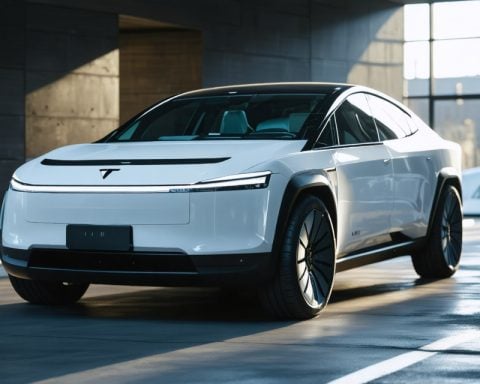- Nvidia’s stock fell over 8%, losing its $3 trillion market cap status, settling at $2.94 trillion, yet it remains a tech giant alongside Apple and Microsoft.
- Key challenges for Nvidia include regulatory pressures, export barriers, and trade tariffs, affecting its 2025 growth outlook amid evolving AI efficiency.
- The company showed a strong financial performance with a 78% increase in quarterly revenue to $39.33 billion, driven by a 93% growth in data center revenue.
- CEO Jensen Huang emphasizes robust demand for next-gen chips, crucial for AI models’ computational needs and partnerships with tech leaders like Microsoft, Google, and Amazon.
- Nvidia’s growth is heavily tied to cloud giants’ spending, with its ability to address complex challenges being pivotal for future success.
- Investors are reminded that growth is non-linear; Nvidia aims to demonstrate resilience and remain influential in reshaping the tech landscape.
A gust of uncertainty whipped through Wall Street as Nvidia’s stock took a dramatic dive, shedding over 8% and promptly dismantling its brief tenure in the exclusive $3 trillion market cap club. Investors watched as nearly $273 billion in value evaporated, jolting Nvidia to settle just under the benchmark at $2.94 trillion. Despite the drop, Nvidia still stands as a towering figure in the tech world, second only to Apple’s dominance and keeping Microsoft at bay.
The storm clouds gather for Nvidia as it braces for 2025 challenges. Concerns about regulatory pressures, export barriers, and brewing trade tariffs loom over its growth narrative. Analysts raise eyebrows at whether Nvidia can maintain its meteoric growth amidst a landscape of more efficient AI models and a cooling pace of tech expansion.
Still, Nvidia’s recent performance wasn’t shadowed entirely by gloom. The company defied analyst expectations with a striking 78% surge in quarterly revenue, reaching an impressive $39.33 billion mark. Their data center revenue, pivotal for powering AI workloads, leaped 93% over the year, suggesting solid ground to navigate the tumultuous seas ahead.
Adding layers to Nvidia’s narrative, CEO Jensen Huang radiates optimism about the robust demand for their next-gen chips. As the world grows impatient for the future promised by AI, more computational firepower is essential. Huang envisions next-gen AI models requiring significantly heavier computational loads, laying out a roadmap where Nvidia’s chips remain essential to the largest tech titans like Microsoft, Google, and Amazon.
Nvidia’s fortunes ride on the mega-spending of cloud service behemoths, accounting for a substantial slice of its lifeblood. Whether Nvidia can recalibrate its growth compass and find innovative answers amidst complex challenges will determine its journey forward. By navigating these pressing hurdles, Nvidia aims to prove its stalwart resilience, ensuring that tech visionaries and investors alike continue to keep their gaze steadfastly on this powerhouse.
As investors ponder Nvidia’s future trajectory, the message resounds: growth narratives are seldom linear, and the real test lies in enduring the tempest and emerging stronger, a testament to Nvidia’s enduring commitment to reshape the tech landscape.
Nvidia’s Volatile Journey: What Lies Ahead for the Chip Giant?
Nvidia’s recent plunge in stock value, dropping over 8% and slipping below the $3 trillion market cap milestone, has rattled investors and stirred discussions across Wall Street. However, this scenario is a reflection of an intricate set of dynamics within the tech industry, particularly in the realm of Artificial Intelligence (AI) and chip manufacturing. Let’s delve deeper into Nvidia’s current position, future prospects, and the broader market conditions influencing its trajectory.
Nvidia’s Position in the Tech Hierarchy
Despite recent market fluctuations, Nvidia remains a formidable force in the technology sector. The company has carved its niche by capitalizing on the burgeoning demand for AI-driven solutions. In the second quarter, Nvidia stunned the market by achieving a 78% surge in quarterly revenue, exceeding $39 billion [source: Nvidia’s Q2 financial report]. Their success is largely attributed to the soaring demand for data center solutions, which reported a 93% year-over-year increase.
Challenges on the Horizon
1. Regulatory and Trade Concerns: As Nvidia braces for 2025, regulatory pressures, particularly in export restrictions and trade tariffs, pose significant risks. These could impact the cost structure and market access, particularly in China – a crucial market for tech hardware.
2. Competitive Landscape: The rise of more energy-efficient AI models presents a challenge as companies look for cost-effectiveness in their operations. Competitors like Intel and AMD continually strive to innovate, presenting direct competition to Nvidia’s dominance.
3. Slowed Tech Expansion: While Nvidia rides the AI wave, a general cooling in tech industry growth could affect long-term forecasts. The shift toward sustainability and efficiency could further complicate their expansion plans.
Opportunities and Innovations
Looking forward, Nvidia’s CEO, Jensen Huang, expresses confidence in the demand for next-generation chips. These advanced chips are expected to meet the massive computational demands of future AI technologies. Nvidia’s strategic investments and partnerships with tech giants such as Microsoft, Google, and Amazon ensure a robust client base that is critical for sustained growth.
How Nvidia Can Maintain Its Edge
– Investing in R&D: Continuing their heavy investment in research and development will be key for Nvidia to maintain its leadership. Focusing on innovative solutions that offer both performance and energy efficiency is crucial.
– Strategic Partnerships: Leveraging collaborations with cloud service providers and tech giants allows for shared growth and access to new markets.
– Diversification: Expanding beyond data centers into automotive, healthcare, and other AI-driven industries can help mitigate risks associated with any one sector.
Market Forecasts & Industry Trends
The global chip market, valued at over $440 billion in 2023, is expected to witness significant growth, largely fueled by AI development, IoT, and 5G technologies [source: Gartner, 2023]. Nvidia’s participation in these emerging sectors positions it favorably, yet adapting to rapid market changes will be pivotal.
Quick Tips for Investors
– Monitor Regulatory Changes: Stay updated on international trade policies which could influence Nvidia’s market strategy.
– Evaluate Competitor Strategies: Understanding moves by key competitors can provide insights into Nvidia’s relative market risk and opportunities.
– Consider Diversification: Investing in a mix of tech stocks, alongside Nvidia, might offer a balanced exposure to growth while managing risk.
Nvidia’s story is a testament to the pulsating nature of tech evolution, where rapid innovation coexists with formidable challenges. As they navigate regulatory landscapes and competitive pressures, Nvidia’s agility in strategy and execution will determine its future market standing.
For more information and updates on Nvidia and the tech industry, consider following developments on Nvidia’s official website.













